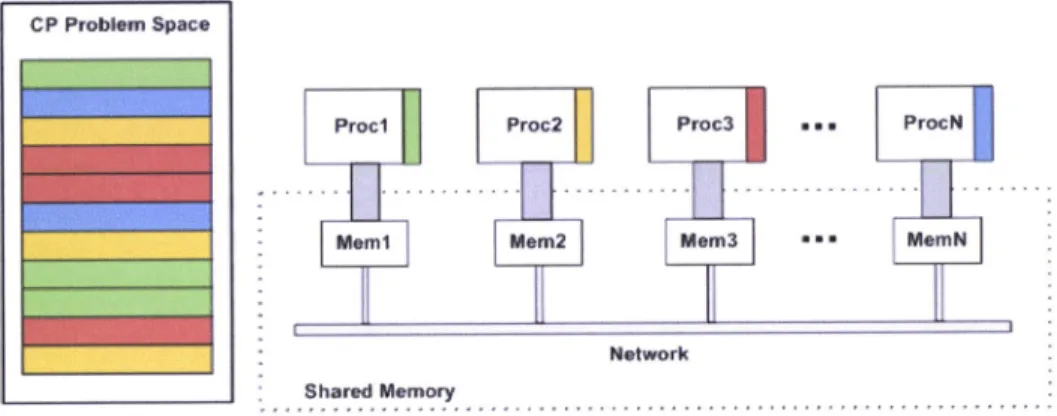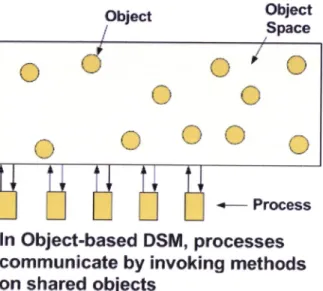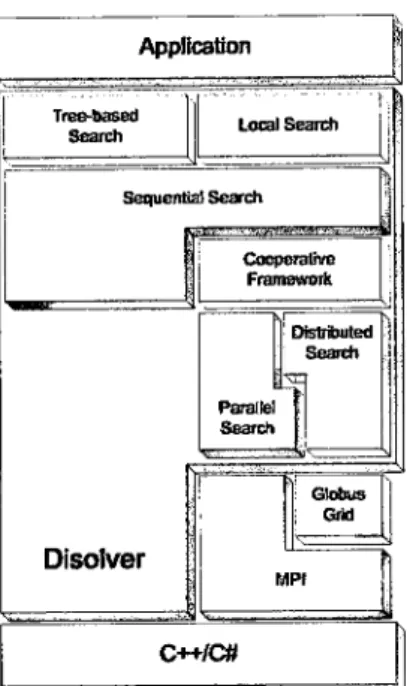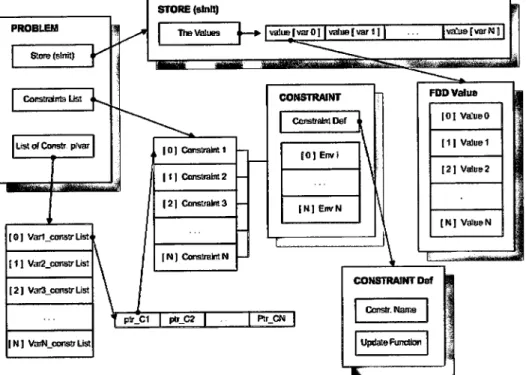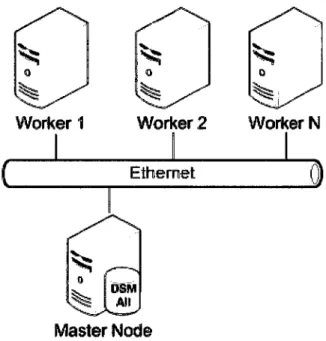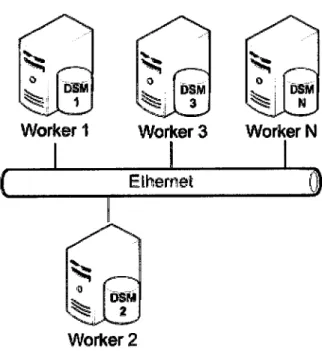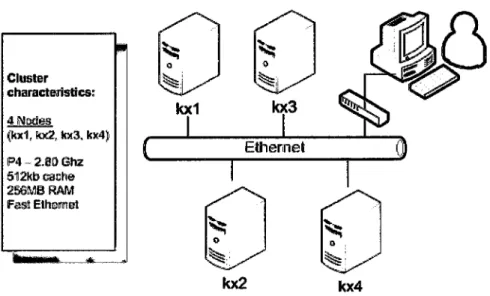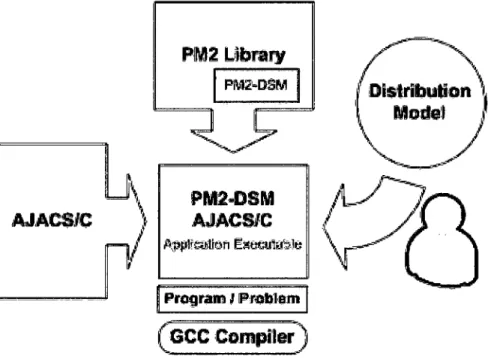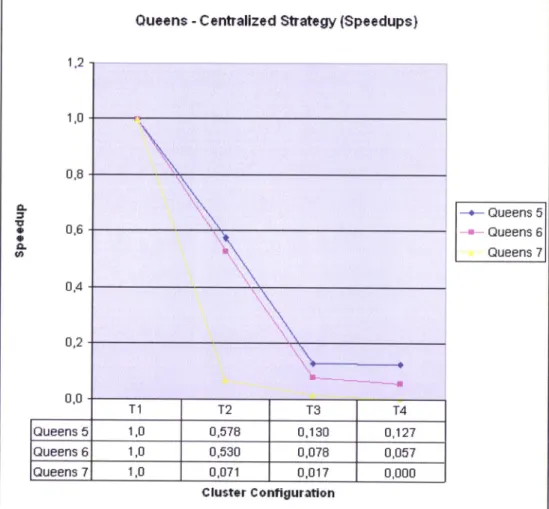Departamento
de
Informática
DSM-PM2
Adequacy
for Distributed Constraint
Programming
LuÍs Pedro
Parreira
Galito Pimenta Almas
(luis.almas @deimos. com.pt)
Supervisor: Salvador
Abreü
(universidade de liVora, DI)Évora
Departa,mento de
lnformática
DSM-PM2
Adequacy
for Distributed
Constraint
Programming
Luís
Pedro
Parreira
Galito
Pimenta Almas
(luis. atmas@deimm.com.pt)
/tv
+3[
Supervisor:
Salvador
Abreu
(Universidade de Évora,DI)
Evora
Abstract
High-speed networks and rapidly improving microprocmsor performance make networks
of
workstations an increasingly appealing vehicle for par-allel computing. Nospeial
hardware is requiredto
use this solution as aparallel computer, and the rmulting system can be easily maintained,
or-tended and upgraded. Constraint progra.mming is a progremming pa,radigm where relations between variables can be stated
in
the form of constraints. Constraints differ from the common primitives of other programminglan-guages in that they do not specify a step or sequence of steps to execute but
rather the propeúies
of
a solutionto
befound.
Constraint progra,mmingIibraries are usefirl as they do not require the developers
to
acquire skills for a new language, proúding instead declarative programming tools for use within conventional systems. Distributed Shared Memory presents itself asa tool for parallel appücation in
whiú
individual shared data iterns can beaccessed directly. In systems that support Distributed Shared Memory, data
moves between main memories of different nodes. The Distributed Sha,red Memory spares the progrnmmer the concerns of message passing, where he
would have to put allot ofefiort to control the distributed system behavior.
We propose an architecture
aimd
for Distributed Constraint Progra.mmingSolving
that
relies on propagation and local search over aCGNUMA
dis-tributed environment using Distributed Shared Memory.The main objective of this thesis can be s rmrnarized as:
o
Develop a Constraint Solving System, based on the AJACS [3] system,in
the C language, the native language of the orperimented Parallel Iibrary - PM2[
];e
Adapt, orperiment and emluate the developed constraint solvingsys-tem distributed suitabiüty by using DSM-PM2 [1] over a CC-NIIMA
architecture distributed environmentl
Keywords: Distributed, Constraint Progra.mming, Parallel, Distributed Shared
Sumrírio
Título:
Adequação
da
biblioteca
PM2-DSM
para
Pro-gra,maçã,o
por
Restrições
Distribúdas.
Âs Redes de alta velocidade e o melhora,mento rápido da performance dos
microprocessadores Ías'em das
rdes
de computadores um veículoapela-tivo
para computação pa,ralela. Não é preciso hardware especial para usarcomputadore paralelos e o sistema
reultante
é ortensível e facilmenteal-terável.
A
progra,maçãopor
restrições éum
paradigma de progra,maçãoem que a.s relações entre as rmriáveis pode ser rqrresentada por retrições. Âs restrições diferem das primitivas comuus das outras liuguagens de
pro
gra,neação porque, ao contrário destas, não specifica uma sequência de pas'
sos
a
executa,r mas antesa defini$o
das propriedades para encontrar assoluções de um problema específico. As bibliotecas de progra,mação por re-strições são úteis visto elas não requerem que «xt progra,madores tenha,m que aprender novos s&nlls para uma nova linguagem mas antes proporcionam
fer-ra,mentas de progra,mação declaratirra para uso em sistemas convencionais.
A
tecnologia de Memória Partilhada Distribuída (Distributed Shared Memory)apresenta-se como urra fera,menta para uso em aplicaçõe distribúdas em
que a informa4âo indiúdual partilhs-da pode ser amdida directs.mente. Nm
sistemas que suporta,m esta tecnologia os dados movem-ae entre as memórias
principais dos diversm nos de um
cluster.
Esüa tecnologia poupao
pr«>gra,mador às preocupações de passage,m de mensagens onde ele teria que
ter múto
trabalho de controlo do comporta,tnento do sistema distribúdo.Propomoc nma arquitectura orientada para a
distribuido
de Progra,maçãopor
Restrições que tenha os mecanismos da propagação e da procura lo-cal como base sobre um a,mbienteCGNUMA
disbribuído usando memória par:tilhada distribuída.Os principais objectivos desta dissertação podem ser sumarizados em:
o
Deenvolver um sistemâ, resolvedor de restriçõs, baseado no sistemaAJACS [3], usando a linguagem 'C', linguagem nativa da bibüoteca de
deenvolvimento paralelo
oçeimentada:
o PM2 [4].o
Adaptar, e»cperimentar e awliar a adequaçãodete
sistema rmolvedorde restrições usando DSM-PM2 [1] a um ambiente distribuído assente
Acknowledgements
Thanks
to
my
fa,mily and Fátimafor
all
the
support;to
my
Supervisor Salvador Abreu forall
the attention and availability provided;to
DeimosContents
I
lntroduction
1
Introduction
and
Motivation
1.1
l-ntroduction .L.2
Constraint Progra.mming.. .
.l-.3
Distributd
Shaxd Memory.
.1.3.1
DSM Desigp1.3.2
DSM AlgorithmsI
10 10 10 L1 L2 13 15 19 20 2L 22 23 24 26 25 26 27 27 28 29 30 35 35 36 37 39 39 L.4 1.5 1.61.3.3
Cousistency Models1.3.4
Coherence Protocol Policy1.3.5
Other Desrgn IssuesDistributed Constraint Progra.mming using DSM Objectives
RoadMap to this Thesis
II
State of
the
Art
2
State of
the
Art
-
Distributed
SharedMemory
2.1
The CC-NIIMA Architecture2.2
DSM on Hardware/
Softwa,re.
.2.3
DSM Systems 2.4 2.52.3.L
PageBased DSM2.3.2
Shared Variable DSM2.3.3
Object-Based DSM2.3.4
DSM Systems Overview DSM-PM2:An
Overview2.4.1
The PM2 runtime system2.4.2
DSM-PM2: The illusion of common address spaceConclusion
3
State of
the
Art
-
Distributed Constralnt
Programming
3.1
Distributed Constraint Progra.mming - from GC to Distributed AJACS3.1.1
GC Concept3.L.2
AJACS Concept3.2
3.1.3
AJACS over l{yperion for Distributed E:recution.
.
.Other DCP Systems
3.2.1
DisChoco: A Platform for distributed constraintpro
gramming3.2.2
The Mozart Progre.mming System3.2.3
Disolver: The Distributed Constraint Solver3.2.4
Alice SystemIII
Description
4
AJACS/C
Description
-
Distributed
Patterns and
Imple-menüation4.L
ÀJACS/C Model DmcriptionA.L.L
AJACS/C Static Model4.L.2
AJACS/C Dyna.mis Model4.1.3
AJACS/C Extensability. .
.Distributed Sharing Patterns with AJACS/C and DSM-PM2
4.2.L
Çsahalized Distribution Pattern4.2.2
LocalDistributd
PatternAJACS/C Tmplementation Details
- API
4.3.L
bittarr.h
4.3.2
constraints.h4.3.3
fdd-value.h4.3.4
problem.h .4-3.5
search.h.
.4.3.6
store.h .4.3.7
strategr.h .fV
Interpretation
of Results
5
Examples and
Interpretation
of
Reults
5.1
PM2 Configuration .5.2
Cluster Configuration5.3
How to create a DSM-PM2 AJACS/C Exa,mple.
.5.4
Queens Exa,mple5.4.L
SpeciÊcation5.4.2
Problem Description5.4.3
Interpretation ofReults
.
.5.4.4
Conclusions5.5
n-Fbactions Exa,mple 4.2 4.3 39 42 45 46 46 46 47 47 51 52 52 53 ao 57 57 58 59 6L 61 69 72 78 79 81 84 86 87 88 88 89 90 90 90 92 98 985.5.1 5.5.2 5.5.3 5.5.4 Specification Problem Description
.
. Interpretation of Results Conclusions 98 99 101 101to4
L05 105 105 105 106 106 L07 108V
Conclusion
6
Conclusionsand tr\rture
\il'ork
6.1
Work performed on this thesis. .
.6.1.1
AJACS/C Development.
.6.L.2
DSM-PM2 AJACS/C Integration.
.
.6.1.3
Distribution Models Design6.1.4
AJACS/C with DSM-PM2 E:rperimentation6.2
ConclusionsList
of
Figures
3.1 3.2 3.31.1
DSM ConceptL.2
DCP using DSM Concept2.1.
Object Based DSM .2.2
Overview of the DSM-PM2 Software ArchitectureL1 22 30 38
M
45 48u
56 57 58 59 59 60 60 614.'1, AJACS/C Static Model
4.2
AJACS/C D;rnamic Model4.3
DSM-PM2 AJACS/C Architecture. .
.4.4
Centralized DSM structure Architecture4.5
Centra.lized Distribution Pattern-
Master Algorithm4.6
Centraliz6{ Distribution Pattern-
W'orkerA§orithm
4.7
Local DSM structure Architecture4.8
Local Distribution Pattern - MasterAgorithm
4.9
Local Distribution Pattern - WorkerAlgorithm
.5.1
E»rperimenting Chrster Configuration.
.5.2
Buitding a DSM-PM2 AJACS/C application..
.5.3
Queens ora,mpleAll
Classm of AJACSDFS searú applied to 4Queens problem Disolver General
Arúitecture
Queens Centralized stratery time rmults Queens Centralized strategy speedup
reults
.Quens Local strategr time
reults
Quens Local stratery speedupreults
n-Fbaction
(n:2)
examplen-Flacti,ons
(n:2)
Local strategr time results n-Flactions(n:2)
Local strategr spedup results5.4 b.b 5.6 o,t 5.8 5.9 5.10 89 90 9L 93 94 96 97 L00 L02 103
Part
I
Introduction:
Constraint
Programming
and
Chapter
1
Introduction
and
Motivation
On this chapter the
mai''
context, basis and goals of thistheis
study a,re prmented to the reader.1.1
Introduction
High-speed networks and rapidly improving microprocessor performance
ma,ke networks of workstations an increasingly appeeling vehicle
for
par-allel computing. No special hardwa,re is requiredto
use this solution as apa,rallel computer, and the resulting system can be easily maintained,
ex-tended and upgraded.
In
terms of performance, improrrements in procmsorspeed and network bandwidth and latency allow networked workstations to deliver performance approaching or exceding supercomputer performance for an incr€a.sing class of applications.
L.2
Constraint
Programming
Constraint progra.mming
is
a progra,mming paradigm where relations be'tween rmriablm can be stated in the form of constraints. Constraints difier from the comr'.on
primitive
of other progre.mming ianguages in that they do not specify a step or sequenoe ofsteps to executebut
rather the propeúies of a solution to be found. The constraints used in constraint progra,mmingare of various kinds: those used
in
constraint satisfaction problems, thosesolved by the simplor algorithm, and others. Constraints are usually
em-bedded
within
a progra.mming language or provided via separate softwarelibraris.
Constraint progra,mming began with constraint logic progra,mming, which
embeds constraints into a logic program. This variant of logic progra.rnming is due
to
Ja,ffar and Lassez, who ortendedin
19E7a
specific class ofcon-straints
that
were introducedin
PrologII
[31].the
first implementationsof
constraint logic progra,mming were PrologIII
[32],CLP(R)
[33], andCHIP
[34]. Several constraint logic progra.mming interpreters exist today, for exa,mple GNU Prolog [35].Other than logic prograrnming, constraints can be mixed with firnctional progra,mming,
term
rewritinB, and imperatinelanguago.
Constraints infunctional progra,mming are implemented
in
the multi-paradigm program-ming language Oz [5]. Constraints a,re embeddd in an ir"perative languagein
Kaleidoscope. However, constraints are implemented in imperativelan-guag6 mostly via constraint solving toolkits, which are separate libraries for an oristing imperative language. ILOG Solver [36] is an exa,mple of zuch
a constraint progra.mming library for
C**.
constraint progrnmming
librarie
are usefrd when building applicationsdeveloped mostly
in
mainstrea,m progra.mming languagm: they do not re'quire the developers to acquire skills for a new language, providing instead
declaratine programming tools for use within connentional systems.
1.3
Distributed
Shared MemorY
Distributed Shared Memory presents itself as a tool for parallel application
or a
groupof
applicationsin
whiú
indiüdual
shared data items can be accesed directly. In systems that support Distributed Shared Memory, datamoves between main memories of different nodes (as illustrated by figure 1.1). Each node can own data stored in the shared address space, and the ownership can change when data moves from one node to another. When a process accesses data in the shared address sPâGr a mapping manager maps
the shared memory addrms to the physical memory. The mapping manager
is a layer of software implemented either in the operating system kernel or
as a nrntime übrary
routine. Note:
Most of the content discussedin
this section stems from a survey of publicly available materials, which are duly identified. ttt aal thqred liemory Netüork Figure L.1: DSM Concept Procll Procl Prcr;í2 PÍoc3 tüemNThe Distributed Shaned Memory spar6 the progremmer the concerns of
message passing, where he would have
to put
allot of effoÉto
control the distributed system behavior. The goal is to proüde him the abstraction of shared memory. Shared memoryprovide
thefastet
pmsible commurrica-tion,hene
thegreatet
opporttrnity for concurent exqution.1.3.L
DSM
Design
The mein problems
that
the DSM approach has to addrms are:o
The mapping of a logically shared address space onto the physically disüributed memory modulm;o
how to locate and acces the neded data item(s);o
how to perserve the coherent view of the overall shared addrms space.To responde to thme problems we refer to the following text, that sintethizes the main considerations when designing DSM systems.
1 The crucial objective of solving those problems is the minimiza-tion of the a,verâ,ge access time to the shared data. Having this gost in
mind, f,s76 strategies for distribution of shared data a,re most frequently
applied: replication and migration. Replication allows that multiple copies of the same data item reside in different local memoúes, in order to increase the parallelism in accessing logicaly shared data.
Migra-1i611 imFlie a single copy of data item which has to be moved to the accessing site, counting on the locality ofreference in parallel applica.
tions.
Beide
that, systems with distributed shared memory have todeal with the cousistency problem, when replicated copies of the sa.me
data exist. In order to preserve the coherent view of shared address space, according to the strict consistency semantics, a read operation must return the most recently written value. Therefore, when one of
multiple copies of data is written, the others become stale, and harrc to
be invalidated or updated, depending on the applied coherence policy.
Although the strict coherence semantics proüde the most natural view of shared address space, various weaker forms of memory consisteucy can be applied in order to reduce latency.
As a consequence ofapplied strategie and distribution ofshared
address space acrosst difierent memories, on some memory reference data item and its copies have to be located and managd acreording to a mechanism which is appropriate for suú architecture. The
solu-tions to the problems úove are incorporated into the DSM algorithm, which can
[s
implemented at the hardware and/or software level.Im-plementation level of a DSM mechanism is regarded as the basic desrsn
decision, since
it
profoundly affects system performance. The other imporüant issues include: structure and gra,nularity of shard data,memory consistency model that determines allowable memory acoeÉxs
orderings and coherence policy (inrmlidate or update).
L.3.2
DSM Algorithrns
The performance of a DSM system is dependent on the coupling between the
applied DSM algorithm and the access patterns generatd by the application.
One of the pmsible classifications of DSM algorithms distinguishes between 2 (...)SR.SW (Sinsle Reader
/
Single \jlrlriter), MRS\M (MultipleReader
/
Single lüriter), and MRIVIW (Multiple Reader/
MultipleWriter).
SRSW algorithms prohibit replication, and migration canbe allowed if the distribution of shared addrws space over distributed
memories is uot
static.
MRSW algorithrns are most oftenencoun-tered in DSM systems. Based on a realistic assumption that the read
operation is generally more frequent than the write operation, they
allow multiple read-only copies of data items, in order to decrease read
latency. Finally, the MRMW alg;orithms allow the o<istence of
mul-tiple opies of data items, even while being written to, but in some case, depending on the consistency semaatics, write operations must
be globally sequeucd.
The algorithms to be dmcribed belos, 3 are categorized by whether they migrate and
/
or replicate data. Two of the algorithms (central-serveralge
rithrn and migration algorithrn) migrate data to the site where
it
is accesed in an attempt tooçloit
local data ac:cffircs decreasi.g the number of remote acces,ses,thls
avoirting communication overhead. The two other algorithms (Read-Replication algorithm and F\rll-Replication algorithm) replicate dataso
that
multiple read accesm can take place at the same time using localacce§s6.
Central-server
Algorithm
In
the Central-§erver Âlgorithm, a central-server maintains all theshared data. It services the read requests from other nodes or clients by returning the data items to them. It updates the data on write requests by clients and returns ad<nourledgment message§. A timeout can be
employed to resend the requets in ca.se of
faild
acknowledgments.Du-plicate write requests can be detected by associating sequence numbers
with write requests. A failure condition is returned to the application
trying to access shared data a,fter several retransmissions without a respo[8e.
Although, the central-server atgorithm is simple fe implement, the central-server can become a bottleneck. To overcome this problem,
shared data can be distributd among several server§. In suú e, case,
clients must be able to locate the appropriate server for wery data
acc€§sl. Multicasting data access requeots is und€sirable as
it
does notreduce the load at the servers compared to the central-sen/er súeme. A better way to distribute data is to partition the shard data by
address and use a mapping function to locate the appropriate senrer.
2Flom http://galeb.etf.bg.ac.yu/ vm/tutorial/multi/dsm/introduction/introduction.html sFlom http://www.niksulâ"cs.hut.fi/projets/ohtdsm/documents/ldrjtutk/cmodels.html
Migration Algorithrn
In
the Migratiou Algorithm, the data is shipped to the location ofthe data access requeot alowing subsequent accasen to the data to be performed locally. The migratiou algorithm allows only one node to acceas & shared data at a time. This is a single reader
/
single writerprotocol, since only the threads executing on one hwt can read or write a given data item at any time.
Typically, the whole page or block containing the data item
mi-grates instead of an individual item requestd. This algorithm ta,k6
advantage of the locality of reference CIüibited by progra,ms by a,mor-tizing the cost of migration over multiple acce§se§ to the migrated data. Ilowever, this approach is susceptible to thrashing, where pages
frequently migrate between nodes while servicing only a few requests.
The migration algorithm proüde an opportunity to integrate DSM
with the virtual memory provided by the operating system running at individuat nodes. When the page size used by DSM i8 a multiple of the
virtual memory page size, a locally held shared memory page can be
mapped to an application's viúual address space and accesed using normal machine instructions. On a memory acces fault, if the memory
address maps to a remote page, a fault-handler will migrate the page
before mapping
it
to the procees's address space. Upon migrating, the page is removed from all the addrqs spacsit
was mapped to at the previous node. Note that severa,l processes can sha.re a page at anode. Tlo locate a data block, the migration algorithm can make use
of a server that keps track of the location of page, or through hints
maintained at node. Thee hints direct the search for a page toward
the node currently holding the page. Alternatively, a query can be broadcasted to locate a page.
Read-Replication
Algorithm
One djsadvantage of the migration algorithm is that only the threads on one host can access data contained in the same block at any given
time. Replication can reduce the average cost ofread operations, since
it
allos/s read operations to be simultaneouslyexeutd
locally (withno communication overhead) at multiple hosts. Floyrever, some of the
write operations may become more eKpensive, eince the replicas may
have to be iwalidated or updated to maintain consistency. Neverthe
less, if the ratio of reads over writes is large, the extra elçense for the
write operations may be more than oftet by the lower average
cct
ofthe read operations.
Replicatiou can be naturally added to the migration algorithm by alowing either one site a read/write copy of a particula,r block or
mul-tiple sites rmd-only copies of that block. This type of replication is referrd to as multiple readers
/
single writer replication.For a read operatiou on a data item in a bloc,k that is currently not
local,
it
ie necessary to communicate with remote sitee to first acquire a read-only copy of that block and to change tored
only the acces rights to any writable copy if necessary before the read operation cancomplete. Fbr a write operation to data in a block that is either not
local or for whiú the local host has no write permission, all copie of
the sa,me block held at other sites must be invalidated before the write
can proceed. The read-replication algorithm is consistent because a
read access always returns the nalue of the most recent write to the
same location.
In
the read replication algorithm, DSM must keep track of the location of all the copies of data blod«s. One way to do this is to havethe orrner node of a data block keep track of all the nodes that have a copy of the data block. Alternatively, a distributd linked list may be
used to keep track of all the nodes that have a copy of the data block.
Ftrll-R
eplication
algorithrn
The firll replication algorithm is an extension of the read replication
algorithm.
It
allows multiple nodes to have both read and write accessto shared data blocks (the multiple readers
/
multiple writer protocol).Because many node can write shared data concurrently, the accms to shared data must be controlled to maintain its consisteucy.
One possible way to keep the repücated data consistent is to
glob-ally sequence the write operations.
A
simple stratery based on sequencing rures a single global sequencer whicà is a proc€§s executing on a host particrpating in DSM. When a procms attempts a write to
úared memory, the intended modification is sent
to
the sequencer. This squencer assigrs the uo<t squence number to the modificationwith this sequence number to all
site.
Each site processes broadcastwrite operations in sequence number order. When a modification
ar-rives at a site, the sequence numb€r is
verifid
as the nexb orpectdone. If a gap in the s4uence numbers is detected, either a modification
was missed or a modiEcation was received out of order, in which case a
retransmiesion of the modiÊcation mmage is requested. In effect, this strategr implements a negative ad«nowledgment protocol.
L.3.3
Consistency Models
DSM systems, as we have
sen,
rely on replicating shared data items for allowing concurrent aosess at ma,ny nodes in order to improve performance.Ilowever,
the
concurrent acoesseÊ needto
be carefully controlled, so thatmemory accessm may be excuted in the order that which the progre.mmel
expects.
In
other words, the memory is coherentif
the nalue returned by aread operation is always the value that the programmer would
elqret, that
a read operation retunrs the value stored by the most recent write operation. Thus, to mainte.in the coherence of shared data, a mehanism to control and
synchronize the accssm is
neesary
The term consistency is used to refer to a specific kind of coherence. The most natural semantics for memory coherence is shrict consistenry, defined
4 "Strict consistency requires the abiüty to determine the latest
write, which in turu implie a total ordering of requwts. The total
ordering of requests leads to inefficiency due to more data movement
and synúronization rquirements than what a program may really call
for.'
Tio counter this problem, DSM systems attempt
to
improve theperfor-mance by proüding relaxed coherence semantics. Next follows several forms of memory coherence a (strict consistency, causal consistency, PRAM consir
tency
&
proceffior consistency, weak consistency, release consistency, entryconsistency and scope consistency).
Strict
ConsistencyThe most stringent consistency model is called strict consistency.
It
isdefined by the following condition: Any read to a memory location X
returns the rmlue stored by the most recent rrrite operation to X. This deúnition implicitly assumes the e»ristence of absolute global time so that the determination of "mmt recent' is unambiguous. Unipro-cesors have traditioually observed strict consistency.
In s'mmarJr, when memory is strictly consistent, all
write
arein-stantaneously visible to all processe and an absolute global time order
is maintained.
If
a memory location is changed, all subsequent readsfrom that location see the uew nalue, no matter how soon after the change the reads are done and no matter which processe are doing the reading and where they are located. §irnilsrly, if a read is done,
it
gets the curent value, uo matter how qúckly the next write is done. Causal
Consistency
The causal consistency model repreoents a weakening of sequential con-sistency in that
it
makes a distinction between events that arepoten-tially causally related and those that are not. Suppose that proces
Pl
writes a variable X. Then P2 reads X and writes Y. Here the reading
of
X
and the writing ofY
are potentially causally related becausethe computation of
Y
mayhave
on the'ualue ofX
read by P2 ( i.e., the value written by P1).
Fbr a memory to be consideredcausally consistent, it is uecesary that the Irremory obey the following
condition: "Writes that are potentially causally relatd must be seen
by all processes in the sa,me order. Concurrent writes may be seen in a different order on difterent rnachinesl.
PRAM
Consistency
&
Processor ConsistencyIn causal consistency,
it
is permitted that concument writes be seen in a difierent order on different machin€a, although causally relatedones must be sen in the sa,me order by s,ll rnae.hines. The next step
in rela:<ing memory is to drop the latter requirement. Doing so give aFlom http://www.nikuls-cs.hut.fi/projects/ohtdsm/documents/kirjtutk/cmodel§.html
PRAM consistency, whiú is subi@t to the condition of all writes being
done doue by a single proc€$t are received by all other proceses in the
order in which they were issued, but writes from different proc€ses may be seen in a difierent order by difierent
proaeɧes-\Àfeak
Consistency
Although PRÂM consistency and procesor consistency can give
bet-ter performance than the stronger models, they are still unnecesarily restrictive for many applications becauee they require that writes orig-inating in a single proc€É§s be seen enerywhere in order. Not all
appli-cations require eveu seei4g all writes, let alone seeing them in order. Considering the case of a process inside a qriticat section reading and
writing some vrariables in a tight loop. Even though other processes
are not supposed to touch the rmriableo until the first procss has left its critical section, the memory has no way of knowing when a proces§ is in a criticat sectiou and when
it
is not, soit
has to propagate allwrites to all memories in the usual way.
\üeak consistency, has three propertim:
L. Accesse to critical (synchronization) variable are sequentially consistent.
2. No acces to a synchronization variable is allowed to be performed
until all previous writes have completed eveqrwhere.
3. No data arces (read or write) is allowed to be performed
un-til
all previous acsesses to synchmuization variables have beenperformed.
Release Consistency
Weak consistency has the problem that when a synchronization vari-able is accesed, the memory does not knovr whether this i§ being done because the process is finich€d writing the úared variables or about to start reding them. Consquently,
it
must take the actionsrequird in both cases, namely making sure that all locally initiated
writes have been completed, a.s well a.s gathering in all writes from other
machines.
If
the memory coúd tell the difierence between entering acriticat region and leaving one, a more efficient implementation might
be pesible. Tb provide this information, two kinds of synchronization
variable or openations are needd instead of one'
Relea,se consistency provide these two kinds. Acquire acce§s€El
are used to tell the memory system that a critical region is about
üo be entered. Release acc€Ésea say that a critical region has just been e»rited. These accsses can be implemented either as ordinary
operations on special variables or as special operations.
Lazy Release Consistencly: LRC is a r€finement of RC that allows consistency action to be pmtponed until a synchronization
rnri-able released in a subsequent operatiou is acquired by another
acquir-ing procesor. Synchronization tra,nsfers in an LRC qrstem, therefore,
invohre only
the
proceÉ!§om. This reduction insynchro-nization traffic can result in a signifi6s1 decrease in the total a'mount
of system communication, and a consquent incre"se in overall
perfor-Inance.
Entry
ConsistencyAnother consistency model that has been desigued to be
usd
with critical sections is entry consistency. Like release consistency,it re
quire the prograrnmer to use acquire and release at the start and end of each critical sectiou, respectively. However, unlike release
consis-tency, entry consistency require each ordinary shared rnriable to be
associated with some synchronization rmriable
suú
as a lock orbar-rier. If it is desired that elements of an a,rray be accessed independently
in parallel, then different array elements must be asociated
úth
dif-ferent locks. When an acquire is done on a synchronization variable,
only those ordinary shared variable Cuaded by that synchronization
variable are made corsisüent. Entry consistency differs from laay
re
lease consistency in that the latter does not associate shared variables
with lod<s or barriers and at acquire time has to determine empirically which variable
it
needs.Formallg a memory exhibits entry consistency
if
it
meets a,ll thefol-lowing conütions:
1. An acquire access ofa sJrnchronization variable is uot allowed to
perform with rmpect to a process until all updates to the guarded
shared data have been performed with repect to that process. 2. Before an exclwive mode access to a qmchronization mriable by
a procss is allovrcd to perform with respect to that proc6s, no other process may hold the synúronization variable, not even in
nonorclusive mode.
3. After an exclusive mode access to a synúronization variable has been performed, a,uy other prrocer next nonexclusive mode access
to that syne.hronization variable may not be performed until
it
has performed with respwt to that variable's o\rner.Scope
Consistency
5Scope Consistency was deneloped by the University of Princetou in
1996. In ScC, the concept of scope is d€úned as all the critical sec-tions. This means the lod«s define the soopes implicitly, rne.king the
concept easy to understand. A scope is said to be opened at an
ac-quire, and closed
at
a releasê. ScC is d€fined as:. When, a WessorQ opens a sape prcvi,otnly closedfu another pnaccssor P, P propagates
the upil,ates made wàthi,n the same sape to 8. As ScC prolmgate les sFlom http://wwwsrg.csi§.bku.bk/srg/htmlÂump.htm
emount of data, the efficiency increases. Ând the updates not
propa-gatd are usually not
nedd,
sinceit
is usual practice for allacree
of the sa,me shared nariable to be gua,rded by the sa,me lock. Summar5r
o
Strict: Absolute time ordering of all shared acceses matters..
Causa}All
processes seeall
causally-related sha,red accesesin
the sa,me order.o
PRAM:All
processm see writm from each prooessor in the order theywere issued. Writes from different processors may not always be in the sa,me order.
o
Weak
Shared data can only be counted onto
be consistent after synchronization is done.o
Release: Shared data are made consistent when a critical region iserdted.
o
Entry: Entryconsistency
laay release consistency in that the latter does not associate shared variables with locJrs or barriers and atacquire time has
to
determine empirically which rmriablmit
needs.o
Scope: Loeks define the scopmimplicitly.
It
propaga,tes less a,mogntof data
/
the efficiency increases.1.3.4
Coherence
Protocol
Policy
After a write operation, the subjacent replicated piece of data becomes out-of-date and must be refreshed acros all replicated sites. Two strategim can
be used to achieve this: write invalidate or write update.
'lMrite
Invalidate
6This protocol is commonly implemented in the form of multi,ple-rco,ilr-si,ngle-uni,tr sh,aring. At any time, a data item may either be:
o accesed in read-only mode by one or more prooesÍH;
o read and vrritten by a single pFocexl.
An item that is currently accqsd in read-only mode can be copied
indefinitely to other pn oe§eeãr. When a proceÍs attempts to write to
it,
a multicast meosage is sent to all other copien to inralidate them,and this is arJ<nowledged before the write can ta,ke place; the other
processۃr are thereby prevented from reading stale
data.
Anypro-cessee attempting to acces the data item are blocked if a writer errists. 6F!om http://www.cs.gmu.edu/cne/modules/dm/purple/wre
Eventually, control is transfered hom the writing proc€§Íl and other
aoceses may take place one the update has been sent. The effect is to process atl acces§€s to the item on a first-comefirst-s€rved basis. This
scheme achievee sequential consistency. \lV'rite
Update
7In the write update protocol, the update made by a procۤs are made
locally and multicast to all other replica mâ.nâ.gers possessing e copy of the data item,
whiú
immediately modiÍy the data read by local processes. Processe read the local copie of data items, without theneed for communication.
In
additionto
allowing multiple readers, several prooesses may write the sa,me data item at the sa,rne time; thisis knourn as
multiplereader-multiplewriter
sharing.Reads are cheap in the writeupdate
option.
However, orderedmulticast protocols a.re relatively erpensive to implement in software.
Eager
VS
Lazy protocols
In an eager protocol, msdiffcafisns to shared data are made visible globally
at the time of a release.
With
a laay protocol, the propagation of modifica-tions is postponeduntil
the time of the acquire.At
this time, the acquiringprocessor determines
whiú
modificationsit
needsto
see. Both eager and laay approache cân be applied to invalidate or update protocols. La,zy pro-tocols are ideally suited for situations where communication has a high cost per message, because they send messages only when absolutely necesârJr,often rmulting in far fewer meffiages overall.
L.3.5
Other
Design
IssuesBesidm the important decisions on úoosing the DSM algorithm (that can
be implemented on
IfW
and/or SW), thebst
suited memory consistencymodel that determinm allowable memory acc6s orderings or coherence pol-icy (invalidate or update), other impoúant issues like:
structure
andgran-ularity
ofshard
data or page replacement are also crucial 8.Granularity
Granularity refers to the size of the shared mernory
unit.
A page size of that is a multiple of the size proüded by the underlyinghard-ware or the memory managemeut system allovrs for the integration
of DSM and the memory mens.gement systems. By integrating DSM
with the underlying memory rnenagement system, a DSM system can
take advantage of the built in protection mechanism to detect
incoher-ent memory reference, and use built iu fault handlers to prevent and
recover from inappropriate references.
Tllom http://www.niksuls"c§.hut.fi/projects/ohtdsm/documents/tirjtutk/cmodels.html
A large page size for the shared memory unit will ta,ke advantage of the locatity of reference eúibited by processes- By transferrhg lsrge
page,
lw
overhead is incurred due to page size, but there is greaterúanee for contention to access a page by many processea. Smaller page sizes are less apt to cause contention as they reduce the likelihood of false sharing.
False sharing of a page occtrs when two difierent data items, not
shaxd but accesed by two different pnoceÁ§€s, are allocatd to a
sin-gle page. So the protocols that adapt
to
a granularity size that isappropriate to the sharing pattern will perform better than those
pre
tocols that make use of a static granularity size. False sharing reults
wheu the system can not distinguish between acoeɧ6 to logically di§-tinct piece of data. False sha,ring occurs because the system tracks
accesses at a granularity larger than the size of indiúdual shared data
items. Conveutional protocols typically require procesۤ to gain sole access to a page before
it
can be modified. Therefore, fal§e úaringcan lead to situations where multiple procwes contest ownership of a
page, even though the processes are modifying eutirely disjoint sets of
data.
Page Replacement
A memory management system has to addres the issue of page replace' ment because the size of physical memory is limited. In DSM systems that support data movement, traditional methods such as least re'
cently used (LRU) cannot be
usd
directly. Data may be accesed indifferent modes such a,s shared, prirrate, read-only, writable, etc-,
in DSM systems. To avoid degradation in the system performance, a
page replacement policy would have to take the Page acces§ modes into consideration. For instance, prinate pa,ges may be replaced before shared pages, a.s shared pages would have to be moved over the
uet-work, possibly to their owner. Read-only pag6 can simply be deleted as their ovruers
will
have a copy. Thus the LRU policy with classes is oue poosible stratery to handle page replacement. Once a page is selected for replacement, the DSM system must ensure that the pageis not lost forever. One option is to swap the page onto disk memory. IIowever, if the page is a replica and is uot owned by the node,
it
can be sent to the owner node.L.4
Distributed
Constraint Programming
using
DSM
On of the inherent characteristics of Constraint Progre.mming aims on
solv-ing problems that may have huge smrch spacs and as so often are very time
consuming tasks. The natural choice is to
try
to paralelize the search space over different CPUs (as ilhrstrated in figure 1.2) in using some paralelizationtec,hnique, being one specific erra,mple the distübution of work over different independent node over some network.
Paralelization does
not
comewithout
cost as applications haveto
be designed specifically for that purpose which meaffi that some decisions have to be made beforehand such a.s:o
The feasabiütyto
partition the workto
be distributed over differentnodes;
o
The needed synchronization, from the problem itself, shall be reduced to a minimum to not generate too much communication between the distributed nodes;o
Some paralelization model needs to be designed, suppoúed by the useof
some specific paralelizatinn libraries(MPI
[3I
alikeor
other) to&ssure a proper distributed computation.
CP ProDLm §pâc.
il.ürcrlí thrrrd memory
Figure 1.2: DCP using DSM Concept
As information must tra,nsit between the different nodes DSM comes a^s
a natural hypothesis choice to ea.se the burdeu caused by the last identified
need, from the items listed above.
The communication abstraction, that DSM sells to offer, is most apealing
since theoretically
it
would eliminate the need for the programmer to waist enersr on mmsage passing management and data consistency acrosÉi memory allocated on each node and allow himto
concentrate/
focus attention onthe distribution model design and on the CSP distributed feasability itself.
1.5
Objectives
This thesis presents an adaptation of the AJACS [3] system to the
'C'
lan-guage and an adequancy study ofthis
constraint solving systemto
adis-tributed enüronment using distributed shared memory, hereby its proposed
to: Procll Proq2 Prcc3 Procl lLmL I.mt Xrml t.m3
o
Develop a Constraint Solving Systemin
the'C'
language, the nativelanguage of the oçerimented Parallel library - PM2 [4] (to be detailed further ahead on this the§is repoú);
o
Adapt and E:rperimentthe
'C'
Constraint Solving Systemto
aCC-NUMÂ
arúitecture
(referto
section 2.1 for details)distributd
envi-ronment using DSM-PM2 [1];o
Ermluate the DSM-PM2 adequacy for distributed constraint prograrn-ming by testing differert distributed approaches and at the sa,me time trying to obtain run-time performance speedups.The work performed in this
th6is
will be preented in 7th International colloquium on Implementation of constraint and Logic Progra.mmingsys-tems [48].
1.6
RoadMap
to this
Thesis
The reminder chapters of this
theis
report have the following prmentation:o On
Chaptens2
and3 is
presenteda
Stateof
the árú summary on the two involved technologie under zubject analysis of this thesis:-Distributed Shared Memory
(úapter 2)
and Distributed Constraint Progra.mming (chapter 3) ;o
On Chnpter 4 the AJACS/C constraint library is described, includingit's
implementationdetails.
The adopted Distribution Modelspro
posed for orperimentation are also explained;
o
Chapter 5 deats withorample
and interpretation of rmults;o
Chapter 6 preents conclusions and future linm of work.Part
II
State
of
the
Art:
Distributed
Shared
Memory
and
Distributed
Constraint
Programmittg
Chapter
2
State of
the
Art
-Distributed
Shared
Memory
This chapter will present the reader a survey on the currently available DSM technolory.
2.L
The
CC-NUMA
Architecture
The chrster configuration used by this thesis report study is based on a
CG
NUMA model. Next follovrs a definition of the CGNUMA architecture as for a comparison
with
other model architetures 1.The term
CC-N[
MA
stands for Caúe-Coherent Non Uniform MemoryAcqs.
In the CGNT MÂ model, the system nrns one oP erating system and shorrs only a single memory image to the usereventhough the memory is physically distributed over the proc€ssors. Since processors ca;n acffis their orrn memory much faster than that of other processors, memory accw is non uniform (NUMA). In thi§
architecture the contents ofthe various procqnor caches should be
co-herent rquirins extra hardware and a cache coherency protocol. A
NIIMÂ compute fumlling these requirements is called a CGNUMA
machine. Refer to figure 1.1.
Comparing
a
CGNUMA computer to MPP (Massively ParallelProcasing)
/
cluster-basd systems and SMP (Symmetric MultiPrq
casing)/PVP (Parallel Vestor Procesi.g) systems shows that CGNt MA machine ca,n
be
as an attempt to get the bwt out ofboth worlds.
SMP/PVP computers have multiple procmors using the sa,me
mem-ory
whiú
ma.kesit
easy to parallelize a code on loop level usingcom-piler options and/or directive. Ilowever, due to the fact that proce. sors have to perform data exchange with their memory over the sa,me
bus having only a limited bandwidth, these systeus will ouly scale to
10s of procesors.
MPP/chrster-based systems do not have this drawback. The node in MPP/cluster-basd machines hane their own prirate memory and therefore each node possesses only a part of the data. Such maúines
will scale upto a very large number of processors if the computation to commuuication ratio of the prograrn i§
high.
The progrsmrning model for these computers is based on me§a'ge pa,sing and procesorsexpücitly have to perform the communication with other procesors
by sending and receiving data- Progra,ms have to take care of data
distribution over the procۤsors and have to be adapted for orplicit
mmmunication. This implies that progra.ms developed for single pre
cessor and PVP/SMP machines cannot be applied to thee machine straight away. A substantial a,mount of redesiping and
reprogra,m-ming of these code is necesary.
CGNT MA machines combine the benefits of MPP/cluster-based systems and SMP/PVP mac'hines. The fact that CGNUMA ma-chine behave like shared memory computers from a user point of
view simpliEes the porting of progrotttc developd for single
proces-sor or SMP/PVP ma,chines. Moreover, CGNTIMA computers allow
for looplevel parallelization by means of compiler options or compiler
directive similar to SMP/PVP systeme. The good scalability
proper-ties are inheritted from MPP/cluster-based systems since memory is
distributed over the node.
2.2
DSM
on
Hard$rare
/
Software
DSM solutions come in two main flavors: Software and Ilardware based-
Hy-brid solutions propose to be the
third
choice. Thme solutions are decribedbelow 2.
Software support for DSM is generally more florible and conve
nient for orperiments than hardware implementations, but in many
cases can not compete with the hardware level DSM in performaace.
Neverthelm, majority of DSM systems
decriM
in the open literaturewere based on eoftwane meúanisms, since networks of workstations axe
getting more popular and poweúil. Therefore, the use of DSM oncept
seems to be an appropriate and relatively low-cost solution for their use as pa,rallel computers. Ideas and concepts that originally appeared in
softwareoriented systems often migrated to the hardware
irnplemen-tations. Software-based DSM mechanisms can be implemented on the level of progra,mmiDg language, since the compiler can detect sha,red acce§ets and insert calls to synchronization and coherence routine into
executable code.
Hardware approach has two very impoúant advantages: complete
transparency to the progra.mmer, and generally better performance
2Womhittp:/
than other approa,che. Since hardware implementations typically use a smaller unit of sharing (e.g., cache block), they are less
suscepti-ble to false úaring and thrashing effects. Hardware implemeatations are particularly superior for applications that have high level of fine
grain sharing. Eardware solutions are da,sifred into three groups:
CC-NUMA
(Cache Coherent Non-Uniform Memory Are,hitecture),COMA
(CacheOnly Memory Architecture), and R.ÜIS (ReflectiveMemory System) architectures. In CGNT MA qrstems, as explained
in sestion 2.1, parts of shared addrw spa'ce are statically distributed
among the local memorie in the clusters of procensors, where the
im-proved locality of acmses is CIrpected. In the COMA architectures, the dishibution of data is dyna,mically adaptable to the application be
havior, so the parts of overall worksparc can freely migra,te according
to its usage. In reflective memory architectures, all write opeations to the globally shared regions are immdiately followed with update of
all other copies of the same data item. Hardwareoriented DSM
meú-gnism appreats to be very promising DSM approach, due to its superior performance and the transparency
it
offers to the progra,mmen-It
ise:rpectd to be more frequently usd in the future.
f{ybrid
solutions may be in order to a,chieve the speed and trans par€rxcy of hardware sche.mes, as well as the flerribility and sophistica.tion of softwaÍe solutions. Deigners sometimes choce to implement a suitable ombinatiou of hardware and software methods. Some level of
software support can be found even in the entirely hardware solutions,
with a goal to better suit to the application behaüor. As none of the
deign choices in the world of DSM has been proven to be absolutely
superior,
it
seems that the integration of various approarJreo will beintensively pursued in future by system architects, in their strive to
gain better performane.
2.3
DSM
Systems
In this section several DSM systems axe presented. Different
§pe
of systemsare introduced and several of their main features are o<posed and compared.
2.3.L
PageBased
DSM
The idea behind
this type of
DSM systemis
to
emulatethe
cacheof
amultiprocessor by making us€ of the rnenxüry rno,no,genxent
unit
(MMU) arrd the operating system software.In
this DSM system, theaddrm
space isdivided into
chunks.
Thme chunks are distributed over arll the proceÉ;sorsin
the system. When a pÍocessor references an addressthat
isnot
local (available in that node), a trap occure, and the DSM software fetches (gets)the chunk ssnfaining the address and rmüarts the faulting instruction, which now complete succmsfirlly. F\rrther characteristics
of this
typeof
DSMsystem are presentd below. 3
Replication
Oue improvement to the basic system that can improve performance considerably is to replicate úunks that a,re read only, read-only
con-stants, or other read-only data struçturen. However,
if
a replicatedchunk is suddemly modified, inconsist€nt copies are in existence- The
inconsistency is preventd by using some consistency protocols.
Findine the
Owner
The simplest solution for finding the orrner is by doing a broadcast,
aski.g for the owner of the sp€cified page to respond. An optimization
is not just to ask who the owner is, but also to tell whether the sender
wants to reed or write and say whether
it
needs a copy of the page.The owaer can then send a single me+sage transferring ournership and the page is well, if needed.
Finding the
CopiesAnother important detail is how all the copie are found when they
must be iilralidated. Agaitr, two possibiütie present themselves. The
first is to broadcast a meÍsage giving the page numb€r and ask all
procffiors [elding the page to inmlidate
it.
This
worls onlyif broadcast messa,ges are totally reüable and can never be lost. The second possibility is to have the owner or page manager
main-tain a list or copyset telling which procesors hold whiú pages. When
a, page must be iwalidated, the old owner, ners owner, or page
man-ager sends a mesage to each proce§or holding the page and waits for
an acknowledgment. When each mesage ha-s been acloowledged' the invalidation is complete.
Page Replacement
As in any system using virtual memory,
it
can happeu that a pageis needed but that there is no free page fra,me in memory to hold it.
Wheu this situa,tion occur§, e page must be evictd from memory to make room for the needed page. Two subproblems immediately arise:
which page to eüct and where to put it.
2.3.2
Shared \Iariable
DSM
Pagebased DSM takm a normal linear address space ând allows
pag6
to migrate dyna,mically oner the netwoÍk. Another, mor€ structured approaeh,is
to
share only a determined set of variablm and data structurmthat
arenedd
by
morethan
oneprocffi.
This way,the
problem cha.ngm fromhovr to do paging over the network to hou, to majntain a potentially repli-cated, distributed data base consisting of the set of
shard
rmriables. More considerations and an example below a.Difierent techniques are applicable here, and these often lead to
major performance improvements. using shared variables that are in-dividually managed also provides considerable opportunity to eliminate false úaring. If
it
i§ possible to update one rmriable without a,ffectingother variables, then the physical layout ofthe variables on the pag6 i§ le*s important. One of the most important exa,mple of suú a system
is Muni,n
191-2.3.3
Obiect-Basd
DSM
In
anobjwt-based distributed
shared memory,
proce§sB onmulti-ple machines (as figure 2.1
iltustrate)
share an abstract space filledwith
shared objects. The location and ma.nagement of the objects is handled
au-tomatically by the system. This model is more abstract and differs
to
theWge-basd, DSM sgstems,
in
whie,h the former provide, in contrast, a raqrlinear memory of bytes from 0 to some maximum. In object-based DSM any
procms can invoke any obj@t's methods, regardlffi of where the procss and object are located. The operating system and runtime system have the task
to
make the act ofinvoki.g
work no matter where theprocms
and the objects are located. An Object-Based DSM feature is that processe cannotdirmtly accۃls the internal state of any of the shaxed objets, so various
opti-mizations are claimed as possible where not pmsible with pagebased DSM. For example, sfutce accffii to the internal state is strictly controlled,
it
may be possibleto
relax the memory consistency protocols. F\rrther detail on Object-Basd DSM characteristis as for its advantagm and disadrrantagm are described below 5.Once a decision ha-q been made to structure a shared memory a§ a collection of separate objects iu§üead of as a linear address space, there
are man1r other choice to be made. Probably the most important
issue i8 whether objects should be replicated or
not. If
replicationis not used, all accesses
to
an object go through the one and only copy, which is simple, but may lead to poor performance. By ailowingobjects to migrate from ma,chine to machine, a.e neded,
it
may bepossible to reduce the performane,e loss by moving objects to where
they are needed.
On the other hand, if objects are replicated, what should be doue
when one copy is updated? One approach is to i$xalidate all the other
copie so that only the up to date copy remains- Additional copies can be created later, on demaud, as needed. An alternative choice is uot to
invalidate the copies, but to update them. Shared-variable DSM âJ§o
at'rom futp,
/ /cs.gmu.edu/cne/modulee/dsm/yello/úared-tlm.html
Obiect Obiect
Space
<-
Processln Object-based
D§ttl,
processes
communicate by invoking methods
on
shared objects
Figure 2.1: Object Based DSM
has this choice, but for page-based DSM, invalidation is the only
fea-sible choice. Similarly, object-based DSM, like shared-variable DSM, eliminates most false sharing.
Object-based DSM has three adyantâges over the other methods: 1.
It
is more modular than the other techniques.2. The implementation is more fledble because accesses are
con-trolled.
3. Synchronization and access can be integrated together cleanly.
Object-based DSM also has disadvantages. Fbr one thing,
it
cannot be used to run old "dusty deck" multiprocessor programs that assume the existence of a shared linear address space that every process
can read and write at random.
A second potential disadvantage is that since all &ccesses to shared
objects must be done by invoking the objects, methods, extra overhead.
is incurred that is not present with shared pages that can be accessed.
directly.
2.3.4
DSM
Systems Overview
Next a set of tables illustrates a set of DSM systems classified as Sofbware,
Hardware or Hybrid (Hardware
/
Software) 6. 6Flom http://galeb.etf.bg.ac.yu/ vm/tutorial/multi/dsm/introduction/introduction.html@/
@@
@
@@
d
@
@
@
@
DSM
Software
S5rsternsName
f4re
of
lrnFle-
menta-tion
ftpe
of
Algo
rithrn
ConsistencliModel
Granularity
unit
Coherencepolicy
r\rY
[4 user-levellibrary
*
OS mod-ifica,tion MSRW sequentiallKb
invaJidate Mermaid t8I user-levelIibrary
*
OS mod-ifications MSRW sequential LKb, gKb invalidateMudn
lel runtime system*
linker
+
Iibrary
*
preprG oessor+
OS mod-ifications type-specific(sRsw,
MRSW, MRMWIweak release variable size
objects
type
specific (delayed update, invalidate) Midway [10] runtime systemf
ç6rnpiler MRIVTW entry, release, proce§sor AKb update Tfead Marks [111user-Ievel MRMW Iazy release 4Kb update,
in-validate Blüzard ÍL2l user-level
+os
kernel modifica-tion MRSW sequential 32-t28b invalidate Mirage [131 OS nelker- MRSW sequential 512b invalidate
Clouds [14]
OS,
out of kernel MRSW inconsistent, sequential 8Kb discard segment when unlockedNerne
Ilpe
of
Trnple.menta-tion
rlpe
of
Algo
rithrn
Consistencl
Model
Granularity
unit
Coherencrpolicy
Linda [15]Language MRSw' sequential variable
(tu-ple size)
imFlem.
dependent Orca
[16]
Language MRSW synchro
de-pendent shared data object size update DSM. PM2
tll
runtime system*
library type-spwific (MRSW MR]VTW sequential,eager
re
Iease,
jana consistency 4kb invalidateDSM Hardware
Systerns NameCluster
Conf
Net
work
of
§pe
algo
rithrn
ConsistModel
Granular
unit
Coherencepolicy
Memnr[1I
single pro-oessor, Memnet device token rrng MRSW sequential 32b invalidate Dash [18] SGI 4D/340(4
PEs, 2-L caúes), Ioc. mem. mmh MRSW release L6b invalidate SCI [1e]Name
Cluster
Conf
Net
work
Tlpe
of
algo
rithrn
Consist
Model
Granular
unit
Coherencepoücy
KSRl [20]6+bit
custom PE,I+D
cachm, 32M loc.mem. rmg-based hiera,r-chy MRSW sequential t28b invalidate DDM ÍzLl 4 MC88r.r.CI 2 caches, &32M local memory bus-based hierar-chy MRSW sequential r.6b invalidate Merlin l22l 4O-MIPS Com-putermesh MRMW proce§§or 8b update
RMS 1231
1-4 pro
ces§or§, cachm, 256M local memory RM bus MRMW proc6s()r 4b updateDSM
Hybrid
SysternsDSM
SystemsCorslstency
Models Comparison
DSM performance is always the major concern. The DSM system,
IÍfY
[4,use
SCbut
performance is poor dueto
excmine data communication in thenetwork.
This major performance bottleneck isrelievd
by later sys.1eme,, which use other relaxed models
to
improve efficiency. For ora,rnple,Munin [9] made use of the weak Eager Release Consistency (ERC) model.
Name
Cluster
Conf
+
Network
Type
ofalgo-rithrn
Consist.Model
Granular
unit
Coherencepol
PLUS I24l M88000, 32K cache, &32M localmemory, mmhMRIVTW prooeffior 4Kb update
Galactica [25]
4
M88LL0s,2-L
caches256M
local memory, meshMRJ\[14I multiple 8Kb
update
/
invalidate Alewife [261 Sparcle
PE,
64IKcache,
4MIocal
mem, CMMU,meh
MRSW sequential 16b invalidate FLASH 124MIPS
T5,I+D
caches, MAGIC contoller, mmh MRSW release 128b invalidate Typhoon [28] SuperSPARC,2-L
caches, NP controller MRSW custom 32b invalidate customIlybrid
DSM [2elFLASH-like MRSW release variable invalidate
SHRIMP t30l
16
PentiumPC
nodes, Intel Paragonroutrng
net-work MRJVIW AURC, scope 4Kbupdate
I
invalidateTheadMarks [11] went a step fuúher, using the weaker Lazy Release
con-sistency
(tRC).
The relative§ good efficiency and simple progra,mmingin-terface Uàb" 'ituadlVtarks remain as the most popular DSM system. On
the other hand, Midway
p0]
adopted a.n even weaker model caJled EntryConsistency (EC), but
it
require progra,m§ to insertorplicit
statementsto
state which nariablm should be guarded by a certain synchronization vari-able. This makes the progra,mming effort more tedious. scope consistency claimsto
be weaker tnanmc,
approarhing the efficiency of EC. As theprogra.mrning interface is enactly the sa,rne as that used by LRC, good
pro
ga.mmability can be ensured.2.4
2.4.L
DSM-PM2: An
Overview
PM2
(Pa,rallel Multithreaded Machine) [4] is a multithreaded environmentfor
distributed architectures.It
proüdesa
POSD( like interfaceto
cre' ate, manipulate and synchronüe lightweight threadsin
user spaoe'in
adis-tributed environment.
Its
basic mechanism for internode interaction is theRemote Procedure CaIl (RPC).
7 Usiog RPC', the PM2 threads can inrrcke the remote execution
of userdefined s€rvice§. such invocations ca,n either be handled by a
prexisting thread, or they can involve the creation of a new thfeed.
While threads running on the sa,me node can freely share data, PM2
thrcads running on distâa node may only interact through RPc. This
mechanism can be used either to send/retrieve information to/from the
remote node, or to have some remote action executed' The rninimal latency of a RPc is 6 micro sec over SISCI/Sq [AA]
*d
8 micro secover BIP [46]/Myrinet [43] on our local Limrx clusters'
plvtz includes t\pp rneirçp6ponents. Fbr multithreadiug,
it
usesMar-cel, cn efficient, userlwel, POSDGke thread pad<age' To ensure net-work portability, PM2 use an efficienrt communication library cattd Madeleine [6], which was ported across a wide range of communication
interfiace, including highperformane one such as BIP [46], SISCI [34!,
VIA [45], as well as mõte traditional one euú as TCR and MPI [3fl'
an intereeti"g frature of PM2 is its thread migratiou meúanism that
allows thread§ to be transparently and preemptively moved from one uode to another duriug their executiou. such a functionality is
typi-catly useful tre implement generic poücie for dyna,mic load balancing' indàpendentty of the applications: the load of each procensing node can
be evaluated according to some mea§ure, and balancd using preemp tive migration. The
by
feature enablin preemptineness is the isoad-dreos alproach to dyna,mic allocation f€atuÍed by PM2. The isomallocThe PM2 runtime
system
?Flom DSM-PM2: A porteble implementation platform formultithreaded DSM con-sistency protocots - Gabriel Antoniu and Luc Bougé'
